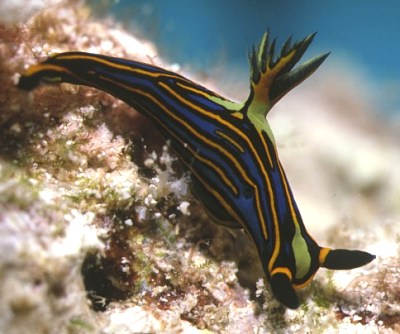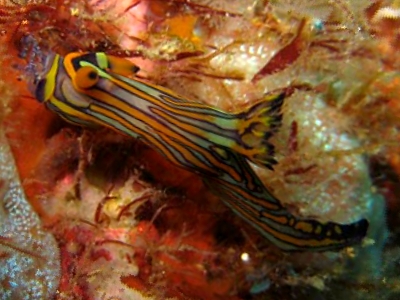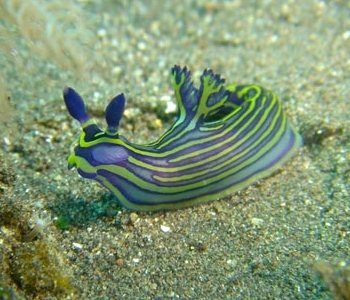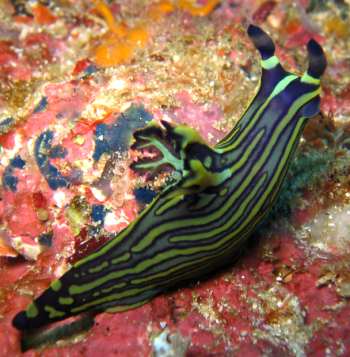
Tambja victoriae
Pola, Cervera & Gosliner, 2005
Order: NUDIBRANCHIA
Suborder: DORIDINA
Superfamily: ANADORIDOIDEA
Family: Polyceridae
Subfamily: Nembrothinae
DISTRIBUTION
Northern Australia, Papua New Guinea, Philippines.
PHOTO
Heron Island, Great Barrier Reef, Australia. 15 metres, December 8, 1997. 28 mm long. Photo: Julie Marshall
The background colour is bright blue with a pattern of longitudinal yellow or yellow-orange lines each outlined with a thin black line. There is a yellow line around the anterior border of the mantle which runs down each side of the body to just behind the gills where it joins in the dorsal midline and runs as a single line some way down the posterior part of the foot. There is a large ovate milky blue-green patch between the rhinophores which continues back to the gills as a thinner yellow line, bordered as usual with black, where it merges with an elongate patch of milky blue-green. The gills sit in the centre of this elongate patch. There are three large, sparsely branched translucent greenish gills. The outer face, or rachis, of the gills is a milky blue-green at the base and yellow above. In both the blue and yellow regions the rachis is outlined with black. The rhinophore clubs are dark blue-black. The raised rhinophore sheaths are dark blue or black with a bright yellow band at the edge. It grows to more than 30 mm in length.
This species has been identified as Roboastra arika Burn, 1967 in a number of illustrated field guides dealing with the Australian fauna although its external shape was clearly not that of a Roboastra. For simplicity, I continued this usage on the Forum. The confusion arose from the original description of the species which was based on a single preserved specimen. In it Burn wrote ‘the live slug was probably bright blue and yellow’ which fits T. victoriae quite well. Roboastra arika is almost certainly a synonym of Roboastra gracilis.
See T. affinis colour group page for a comparison of similarly coloured species.
- Burn, R.F. (1967) Notes on an overlooked nudibranch genus Roboastra Bergh 1877, and two allied genera (Mollusca: Gastropoda). Australian Zoologist, 14: 212-221.
- Pola, M., Cervera, J.L. & Gosliner, T. (2005) Four New Species of Tambja Burn, 1962 (Nudibranchia: Polyceridae) from the Indo-Pacific. Journal of Molluscan Studies, 71: 257-267
Rudman, W.B., 2005 (August 15) Tambja victoriae Pola, Cervera & Gosliner, 2005. [In] Sea Slug Forum. Australian Museum, Sydney. Available from http://www.seaslugforum.net/find/tambvict
Related messages
Roboastra arika? from Similan Thailand
March 12, 2007
From: Napas Golf

Dear Bill,
Is this Roboastra arika?. It has tri-colours, different from the book and from others I had found. The second picture is from Komodo).
Locality: Upper photo: Similan Island, 20 m, Thailand, Andaman Ocean, 14 Feb 2007, Wall. Length: 1.5 inches. Lower photo: Komodo Island, Indonesia. Photographer: Napas Golf.
Best regards,
Napas
napaschon@gmail.com
Napas Golf, 2007 (Mar 12) Roboastra arika? from Similan Thailand. [Message in] Sea Slug Forum. Australian Museum, Sydney. Available from http://www.seaslugforum.net/find/19614
Dear Golf,
The animal Bob Burn described as Roboastra arika is almost certainly a synonym of R. gracilis. Unfortunately Burn based his description on a preserved specimen which had no accompanying photo. The animal which has been mistakenly identified as Roboastra arika in the popular literature, is in fact a species of Tambja, which has recently been named Tambja victoriae. From photos such as yours, we can say that this species is quite variable in colour.
Best wishes,
Bill Rudman
Tambja victoriae from the Philippines
September 3, 2005
From: Reindert Grooters

Hello,
I photographed this species in February this year and could not find the species name. To me it seems like Nembrothinae subfamily, like Tambja, Nembrotha or Roboastra. Can you identify it?
Locality: Gunther's Wall, Limaswawu Island, Southern Leyte, Philippines
Mindanao Sea. Depth: 38 meters. Length: 4 cm.1 February 2005. coral slope. Photographer: Reindert Grooters
Reindert Grooters
mieke.reindert@chello.nl
Grooters, R., 2005 (Sep 3) Tambja victoriae from the Philippines. [Message in] Sea Slug Forum. Australian Museum, Sydney. Available from http://www.seaslugforum.net/find/14703Dear Reindert,
This is the recently named species Tambja victoriae. At present it is known only from Papua New Guinea and northern Australia, so this is an interesting extension of its geographic distribution.
Best wishes,
Bill Rudman
Roboastra arika from Heron Island
January 23, 2001
From: Julie Marshall

Note added 16 August 2005: This has been re-identified as Tambja victoriae.
Dear Bill,
Here is another picture for your Roboastra arika page photographed at Heron Island, Great Barrier Reef, on December 8, 1997. It was 28 mm in size and was found at 15 metres at "Coral Cascades" dive site. Roboastra arika is one of the most common subtidal species found at Heron Island.
Regards,
Julie Marshall.
j.marshall@latrobe.edu.au
Marshall, J., 2001 (Jan 23) Roboastra arika from Heron Island. [Message in] Sea Slug Forum. Australian Museum, Sydney. Available from http://www.seaslugforum.net/find/3603Thanks Julie,
Bill Rudman
